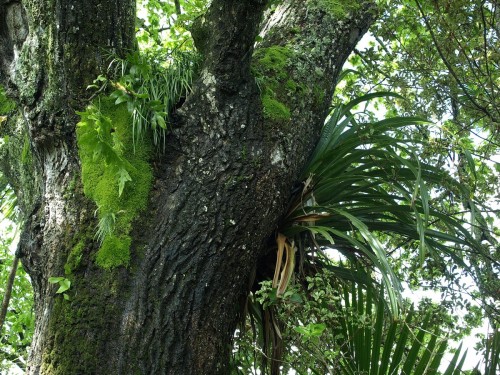This article was published in the Titirangi Tatler, November 2011
English Oaks and their Epiphytes
Not long before the demise of the Waitakere City Council, we received a letter saying a council staff member had seen our driveway lined by 18 very old English oak trees and wondered if we would like to have them listed on their heritage register. We have assumed the trees were planted by the first settler in the area, perhaps 150 years ago, and we have lived with the trees all our lives. There being no good reason not to register them we willingly agreed. That was in August, and in the equinoctial winds of September 2010, one of the largest and healthiest trees was blown over. It seemed tragic and disastrous, but as we got used to the new circumstance, we could see that the fallen trunk and some surviving branches rather added to the ancient feel provided, not just by the oak trees, but by the heavy load of epiphytes that festoon their branches. The fallen oak has a long list of NZ native species that have re-colonised it, providing habitat and ambience that is both novel and attractive.
The ecologist Dr. Geoff Park coined the phrase "Middle New Zealand" where the native components of our environment meet the introduced exotic elements and make a mixed community. In an attempt to hasten the process, I have planted vines such as Three Kings Bignonia (Tecomanthe speciosa), native passionfruit (Passiflora tetrandra) and supplejack (Ripogonum scandens) to scramble up into the oaks and provide some indigenous habitat in a foreign realm.
But my effort is puny compared to Mother Nature, who has gone about the reclaiming of her territory from the upstart colonials with vigour.

Most prominent is the widow-maker (Collospermum hastatum) forming large flax-like clumps astride the oaks' outstretched branches. In greatest abundance is hound's tongue fern (Microsorum pustulatum) with broad flat leaves tightly encircling the branches as a skirt, interspersed with the smaller foliage of leather-leaf fern (Pyrrosia eleagnifolia) as it opportunistically creeps towards the light. Then there are three clump-forming ferns. They are all members of the Spleenwort family - but none the worse for that horrid name. The boldly shining spleenwort (Asplenium oblongifolium) has the longest fronds out to a metre. The lank, loose fronds of hanging spleenwort (Asplenium flaccidum) fall vertically, and the most graceful sickle spleenwort (Asplenium polyodon) shyly retires beneath the dense foliage of the widow-maker.
Three species of epiphytic orchids are gaining the critical mass to make a rapid expansion to other available sites. The two Earina species provide a heady scent when they flower. Earina mucronata has just finished its spring flowering while the aptly named Earina autumnalis flowers in autumn. The third species is Winika cunninghamii , the elegant and pendulous relative of the many exotic Dendrobium orchids.
Of three common epiphytic native shrubs or trees, the only one that has established on the oaks is puka (Griselinia lucida). Its bold glossy leaves are always bright, but look dramatic during winter when the oaks have lost their own leaves and look rather drab. We have planted the other two epiphytic shrubs on the ground nearby and await nature's intercession to establish them on the oaks in due course. They are two shrub forms of Pittosporum (P.kirkii and P. cornifolium) which are normally only ever seen high above your head in mature native forest as they dangle from the fork of a large Podocarp or broadleaf tree such as puriri. They also make delightful garden specimens if given a very free-draining soil.
Then there are numerous native mosses and lichens that love the deeply-furrowed oak bark. They find the conditions ideal for them to establish and hold on through the seasonal changes under the deciduous canopy.
As a consequence of having registered the colonial English oaks, we have since been able to take advantage of the Council's funding to provide management assistance, and have had experienced arborists swing through the branches, pruning to remove dead wood and disease from our early colonial settlers. Now they have a better chance of remaining alive for perhaps another 150 years.

